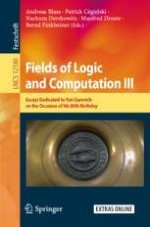2020 | Buch
Fields of Logic and Computation III
Essays Dedicated to Yuri Gurevich on the Occasion of His 80th Birthday
herausgegeben von: Prof. Dr. Andreas Blass, Patrick Cégielski, Nachum Dershowitz, Prof. Dr. Manfred Droste, Prof. Bernd Finkbeiner
Verlag: Springer International Publishing
Buchreihe : Lecture Notes in Computer Science
